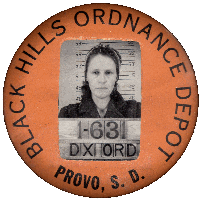


Although I have no proof, this may be a badge that was assigned to an Italian POW

Myrtle O'Banion, circa 1943

Peter Rostad, circa 1944

Adelaide Ward, circa 1943

Sylvan A. Davis, circa 1943

Millie Hardman, circa 1943
| Vol. II No. 12 | page 8 | March 26, 1943 |
Webster's definition of photography is, "The art or process of producing images on sensitized surfaces by the action of light." The life of a photographer or one who is skilled in the art is most generally overshadowed by the light of criticism. There is most generally overshadowed by the light of criticism. There is just one Clark Gable and one Lana Turner, so we silently suffer with our deficiencies and realize that we are what we are, which brings us to the likeness of ourselves on the Photo Identification Badge which we all wear at the Black Hills Ordnance Depot.
The process of making the badge involves the taking of the photo with the camera and the processing of the film. In the development of the film, the first step is immersion of it in the developing solution for several minutes; then placing it in the stop bath which is to stop the chemical action of the developing solution; and then placing it in the Hypo or fixing solution for about 15 minutes. Then the film is washed in water for about 30 minutes and hung up to dry. Thus we have what is known as a negative from which prints are made on sensitized paper. The making of prints is done by placing the emulsion, or dark side of the negative, against the chemically sensitized paper and exposing to a bright light for a short period of time. The condition of the negative and the type of paper used for printing determines the period of exposure. Then the sensitized paper is placed in a chemical solution similar to that used in developing negatives for a short period of time, and immediately placed in a Stop Bath solution for about ten seconds and placed in a circulating washer filled with water. After a brief period of washing, during which all the chemical solutions are eradicated, the prints are placed upon a ferrotype plate, wrung through a wringer, like an old fashioned washer wringer, to squeeze out the moisture in the print and then placed on a rack to dry. When the print is thoroughly dry it loses its adhesion to the ferrotype. The result is the small picture which you see on the Identification badge. The process of making the badge itself will be taken up in some future article. In a survey of the photo badges of the Ordnance Depots, the Black Hills Ordnance Depot employees have more than their share of good looking people. The approximate cost of making photo badges is the sum of $1 and this is the amount to be paid when you lose your badge.
Frederick E. Wheeler